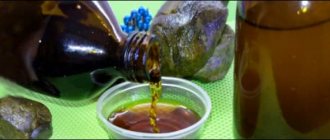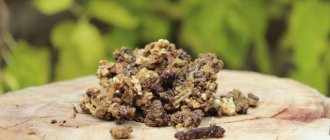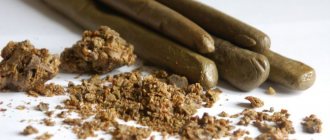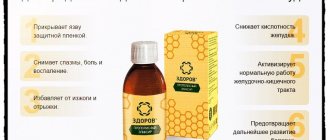Propolis tincture for children: how to make it at home. In apiaries, beekeepers take more than just honey from the hives. Other substances produced by bees in the course of their life are also beneficial to human health. One of them is propolis. The name of the substance (“propoliseo” means “to cover”) directly indicates its purpose: bees use propolis as a building material.
Propolis comes in two types, differing in density. More liquid propolis is used by bees to disinfect hives; it contains components that have antimicrobial and other protective qualities. Insects use viscous propolis to seal cracks in hives. Beekeepers extract propolis by cleaning it from the walls of the bee's home.
The healing properties of propolis for children
Bees produce propolis from resinous substances that have bactericidal properties. Insects collect resinous balsams from trunks, branches, leaves, cones, buds of trees, shrubs, and herbaceous plants. Most often, bees collect resinous substances in birch groves, poplars, and aspens. Propolis collected from birch trees will be colored greenish, aspen propolis will be gray or dark brown. Resins protect plant cells from external contaminants.
Bees use propolis to protect themselves from pathogenic organisms and predators that have died in their nests - small rodents and aggressive insects. Their bodies are sealed with propolis. Honey-bearing insects add a complex of enzymes from their glands to the composition of plant balms. In this way, the chemical composition of the resins becomes more complex and the sticky substance propolis is formed, which consists of 50% organic acids and 10% essential oils.
In total, propolis contains about 200 different elements. The chemical composition of propolis is not constant; it depends on many factors, including the location of the hives, weather and climatic conditions. Natural antibiotics, polyphenols, flavonoids, vitamins, sugars, mineral compounds, ketones, tannins, and lactones are found in various types of propolis.
Propolis contains ash residues, the composition of which depends on the components included in the plant tissue. These can be various microelements - aluminum, zinc, iron, copper, magnesium, chromium, selenium, fluorine, calcium. The vitamin composition of propolis can also change, but most often it contains B vitamins, as well as C, A, P, E, H. The antibacterial and anti-inflammatory qualities of the substance are provided by organic acids - benzoic, ferulic, caffeic.
Propolis contains the acid arginine, which is not produced in sufficient quantities in children, but is necessary for their body. Among the essential acids, propolis contains tryptophan, valine, histidine, leucine, isoleucine, lysine, threonine, phenylalanine, methionine, which are not synthesized not only in children, but also in adults. The lack of these substances affects the development of children's mental abilities, and adults experience memory problems.
Propolis has a bitter taste, so it is not used in its pure form for internal consumption. The color of the substance can range from yellow to black. Dissolve propolis in water and alcohol. Up to 75% of the substances that make up propolis are converted into alcohol. Water is a poor solvent: no more than 11% of propolis components pass into water. When heated to 80 °C, propolis begins to melt, but the substance does not lose its beneficial qualities.
Honey for children: beneficial properties and contraindications
The use of propolis for the prevention and strengthening of children's immunity
Propolis or “bee glue” is an incredibly useful and unique product that bees initially learned to earn for their own needs. It is called glue because it has an adhesive base, because bees produce it based on tree resin.
Interesting fact! As children, many children pick small black circles called resin from the bark of trees (mostly cherry or apple trees). They are usually quite difficult to chew and have to be dissolved. It is this product that forms the basis of propolis, so children on a subconscious level, taking the resin for a treat, improve and maintain the functioning of their body.
The product is based on vitamins, amino acids, including essential ones, enzymes, natural antibiotics and a host of other healing substances, so it is not surprising that the range of its healing effects is incredibly wide. If we talk about how to prepare propolis for a child for immunity, then it is worth immediately paying attention to the rather extensive variation in the methods of preparing and using medicines. You can take propolis in its natural form, or in the form of a tincture or infusion of water (and an aqueous solution of propolis is especially recommended for use by children, because they are not recommended to use alcohol-containing products), candles, a milk drink, and so on.
Ready-made propolis tincture 20% can be ordered by phone:
+380984298830 +380955638797
What does propolis tincture help children with?
Propolis tincture for children: how to make it at home. In the old days, propolis was used to strengthen children's health from the first minutes of a baby's birth. To protect newborns from blood poisoning, propolis was placed on the navel. The healing process was faster and without complications. The antiseptic properties of propolis were used to treat diseases of the oral cavity and intestinal infections. Toys and other objects that the child could pick up and pull into his mouth were treated with a propolis solution.
Now the range of use of propolis for the treatment and prevention of childhood diseases has become much wider. Preparations based on propolis are actively used in the treatment of stomatitis and other infections in the oral cavity, childhood colds and skin diseases, for healing wounds, and to relieve pain. For older children, propolis is prescribed when skin rashes appear during puberty, for general strengthening of the body, for the treatment of chronic diseases, and increasing immunity.
Treatment with propolis tincture for children and adults. Video
Various public sources were used to write this article. All information on this page is of an encyclopedic nature only and cannot be used for self-medication! Please, at the first symptoms of the disease, consult a doctor immediately.
The ointments, tinctures, decoctions, suppositories, and creams containing bee glue described in the article are not medicines. Traditional medicine has contraindications. We strongly recommend using these products under the supervision of a physician.
If you find an error, please select a piece of text and press Ctrl+Enter. All materials are protected by copyright. If an article (or part of it) is copied, an active link to the source is required.
At what age can propolis be given to children?
Traditional healers most often do not place age restrictions on the use of propolis. But doctors working according to the principles of traditional medicine warn that the drug should not be used to treat children under 3 years of age. If there is a need to use propolis for children over 3 years old, first a test is carried out to ensure that the child does not have allergic reactions to the components of the substance. It is carried out in the presence of a pediatrician. All actions with propolis must be carried out only in agreement with the doctor monitoring the child.
Rotavirus infection in children: treatment at home
Propolis for small children
A child is born, and the poor mother is burdened with so many worries that sometimes she simply does not remember whether she did something or not.
It’s good when a baby is born healthy and nothing hurts, although this is very rare, but if something hurts - what to do, where to go, what medications can be taken and which ones cannot. You can get rid of some problems using propolis treatment for children in combination with other folk remedies.
To keep the baby's skin clean and free from diaper rash, bathe him in a bath with the addition of celandine, but if you add a few milliliters of water infusion of propolis or brew celandine with propolis, the effect of such a bath will increase several times. Various dermatitis, sweat rashes, and diathesis will go away with some water. Just be careful, check the baby’s skin reaction to an allergy to propolis.
How to prepare propolis at home
Propolis tincture for children. Before using propolis, it must be examined. If foreign inclusions are visible in the propolis ball - specks, sawdust, pieces of wax, preliminary cleaning of the substance is carried out. Pieces of propolis are soaked in water. The floating debris is removed. Propolis is dried.
Aqueous solution of propolis for children
Propolis at room temperature has the viscosity of a plate. In order for propolis to be divided into small parts, it must be placed in the refrigerator. At low positive temperatures, the substance hardens and becomes brittle; it is easy to break it by covering it with gauze and hitting it with a hammer, or crush it by passing it through a grater.
Propolis solution for children should not exceed 5-10% concentration, so for preparation take 5 or 10 g of the substance and, accordingly, 95 or 90 mm of clean spring or settled boiled water. Having decided on the proportions, combine water and propolis in a clean enamel bowl and place in a water bath for 40 minutes.
The mixture is constantly stirred. Then the liquid is poured into a clean glass jar, closed with a lid, and wrapped in a thick towel for 6-10 hours. After the composition has cooled, it is filtered. Store in a sealed container in the refrigerator. Shelf life 3-5 days.
Alcohol-based propolis for children
To prepare a 10% propolis tincture with alcohol, you need to have 10 g of the substance and 90 mm of 70% medical alcohol. Propolis must be crushed. The smaller the particle sizes, the easier they will dissolve. Crushed propolis is placed in a dark glass pharmaceutical bottle with a capacity of 150-200 mm, and alcohol is added. Close with a lid. Leave in the room in a dark place for 2 weeks.
Shake the jar every day. Do this at least 2-3 times a day. After 14 days, the tincture is placed in the refrigerator for 5-10 hours. Undissolved propolis particles should harden during this time. The tincture is filtered, poured into a clean container, closed, and stored in a shaded place out of reach of children. Alcohol purified tinctures of propolis can be purchased in pharmacies.
How to boost your child's immunity at home
Propolis in the fight against Helicobacter pylori
The cause of abdominal discomfort is the Helicobacter bacterium.
Manifests itself in the form of heaviness, heartburn, belching, nausea and vomiting.
When the immune system is functioning normally, such illnesses behave quietly.
But as soon as the immune system fails, the entire digestive system also fails. These parasites are one of the causes of gastritis, stomach and intestinal ulcers.
The most important thing is to diagnose it in time. In medicine, antibiotics are used to combat this. This treatment method is harmful for children.
Traditional medicine advises taking natural products: nuts, lemon, dried apricots, garlic, ginger and honey to improve immunity.
But treating children with Helicobacter infection with propolis is much more effective.
Children should be given an aqueous extract of propolis, five drops. Add a spoonful of honey and lemon. Use morning and evening.
If it was not possible to eradicate completely, then take a break for one or two weeks and repeat.
It is also recommended to use nuts in your diet. Nuts boost immunity well, influence this pathogen, and prevent it from growing and developing. And if anyone is not afraid of lemon acid, then you need to include lemons in your diet. And combining lemon with honey can strengthen the immune system, which is important for children’s health
In addition, you can use ginger . It is so fierce that it even kills cancer cells. Ginger has a detrimental effect on Helicobacter bacteria.
You can also use garlic . It is accessible, cheap, practical and makes it possible for children to use it.
To prevent and treat the disease caused by Helicobacter pylori, honey whipping - a unique remedy made on the basis of medicinal herbs, honey, and spices that are beneficial for digestion. In addition, the tincture contains a number of vitamins and minerals. Folk honey sbiten will not only eliminate all symptoms of diseases of the gastrointestinal tract and digestive organs, but will also permanently eliminate the cause of its occurrence.
https://youtu.be//FKqxHL2suP8
How to take propolis for children
Propolis tincture for children: how to make it at home. Alcohol tincture of propolis is not used to treat children under 3 years of age. For babies of this age, use a water infusion of propolis, one drop for each year of life, they are diluted in 100 ml of water. Before using propolis for the first time, a check is made to ensure that the child does not have allergies.
For immunity
To prevent colds, to prevent exacerbations of chronic diseases, viral epidemics in children's groups, doctors recommend that parents give children aged 3 to 7 years 3-7 drops of 5% alcohol tincture of propolis once a day before dinner. The medicine is used in diluted form.
For 3 year old children, 3 drops of propolis are diluted in 1 tbsp. boiled warm water or milk. The liquid can be mixed with a few drops of honey. For each child's year, one drop of medicinal tincture is added. The course of using propolis to strengthen the child’s immune system is 10 days.
For a cold
For colds, it is recommended to add water-based propolis drops to warm water and let the child breathe in these fumes.
If your throat hurts
For sore throat, gargle: 10 drops of tincture are mixed with 150 ml of warm boiled water.
With a runny nose
Using a cotton swab soaked in an aqueous 1% propolis solution, wipe the mucous surface of the child’s nose from the inside. The same weak solution is used for nasal instillation - 1 drop in each nostril 3-4 times a day.
Goat's milk: benefits and harm for a child
When coughing
Propolis tincture for children. Propolis tincture with alcohol is mixed with warm milk and honey and given to children from 3 to 7 years of age to drink no more than once a day. The number of drops should correspond to the age of the child. Thanks to honey, the healing properties of propolis are enhanced and its anti-inflammatory and antibacterial effects are increased. For children from 7 to 12 years old, make a mixture of milk, honey and an age-appropriate number of drops of alcohol tincture. You can take the medicinal composition up to 3 times a day. The duration of treatment is no more than 7 days.
For wounds, abrasions, burns
To disinfect lesions on the skin, use an alcohol tincture of propolis. A cotton-gauze swab is soaked in it and applied around the affected area. Treatment of open wounds is carried out only with pharmaceutical products containing propolis components. Wound treatment is carried out after receiving doctor's recommendations. You can apply a tampon with homemade propolis tinctures only to microtraumas on the surface of the skin and to pustular rashes.
Providing first aid to children
For diseases of the heart, gastrointestinal tract
The possibility of using propolis for the treatment of cardiac or gastrointestinal pathologies in a child is determined by the attending physician. Self-medication in these cases is unacceptable, especially with tinctures made at home that have not undergone thorough cleaning from mechanical and chemical contaminants.
Propolis for various diseases
Inhalations with propolis are used to increase the body's defenses, eliminate inflammation of the airways, and thin mucus. In addition, inhalation is carried out for rhinitis, dry cough, inflammation of the nasal sinuses (sinusitis, sinusitis, etc.). The procedure is recommended to be carried out at intervals of 2 – 3 hours.
Inhalations are carried out with pure propolis; for this, 3 g of the substance is crushed, heated in a water bath and poured with 1 glass of boiled water. Application is quite simple: the child tilts his head over the container and inhales the vapor. The frequency of use of the product is from 4 to 6 times in 24 hours for 10 days.
If you have a nebulizer in your first aid kit, then pour a water or alcohol tincture into the tank and inhale the steam. Small particles of the solution penetrate into the deep layers of the mucosa, eliminating inflammation and speeding up recovery. The infusion is diluted with saline solution in a ratio of 1:20. They breathe in pairs twice a day for 15 days. Thus, the product is used during breastfeeding.
Propolis tincture with cough milk is also a popular remedy. To prepare it, boil 1 liter of milk, add 50 g of bee glue to the container, mix and filter. The medicine is taken orally by children in 50-75 ml 3 to 5 times a day.
Propolis for a runny nose is used orally for children or the nose is treated with tincture. The alcohol infusion is diluted with water or milk and swallowed three times a day. Propolis in the nose in liquid form is pre-mixed with saline in a ratio of 1:10 and the mucous membrane is treated. The frequency of the procedure is 2 times in 24 hours.
For otitis, the ear cavity is instilled with 2 drops of tincture three times a day. To treat a sore throat or inflammation of the pharynx, the tonsils are treated with water infusion for 7 to 14 days. In the same way, the remedy is used for inflammation of a woman’s ear during breastfeeding. For diseases of the oral cavity (stomatitis, gingivitis, toothache), rinse is used. To do this, 15 ml of infusion is diluted in 100 - 200 ml of water. Rinse your mouth with a warm solution 4 to 5 times for 5 to 7 days.
To eliminate wounds or abrasions, the damaged areas are wiped with cotton wool soaked in the infusion 1 to 3 times in 24 hours. To treat skin diseases, ointment with propolis, petroleum jelly and glycerin is used. And rectal suppositories based on bee glue help with anal fissures and hemorrhoids in a baby.
Propolis for adenoids in children: properties and methods of use
Propolis - bee glue
Propolis can be used during therapeutic measures. This is a product of natural origin. It is used to prepare healing tinctures aimed at suppressing inflammatory diseases. However, propolis has a number of contraindications for which such treatment is unacceptable. They need to be known before including a beekeeping product in a course of therapy.
Schemes, dosages and methods of administration
There are several ways to treat adenoids with propolis-based products:
- An ointment based on butter and propolis is used to lubricate the inner surface of the nasal passage. Before the procedure, it is recommended to clear the child’s sinuses of accumulated mucus. It is enough to use this method two to three times a day until the symptoms disappear, but not more than 3 weeks.
- To increase the body's resistance, children are given a water infusion to take orally. Children from 3 to 5 years old - 0.5 tsp. three times a day, children from 5 to 7 years old - 1 tsp, children over 7 - 2 tsp. three times a day before meals.
- An alcohol infusion is used to rinse the sinuses. To do this, add 20 drops of 5% tincture for children under 7 years of age or 20 drops of 10% for older children to a glass of cooled boiled water. You also need to add baking soda to the solution - 1/3 tsp. The washing procedure should be carried out three times a day for no more than a week.
- For adenoids, it is useful to put pure propolis in the child’s nose for 10–15 minutes. It is enough to repeat the procedure twice a day.
- Another good remedy is to use cotton swabs soaked in oil infusion. It is enough to repeat the procedure two to three times a day.
To increase immunity, it is recommended to give the child to chew a small piece of pure propolis several times a day. The method not only saturates the body with useful microelements, but also stimulates appetite and improves digestion.
At the initial stage
At the initial stage of adenoid inflammation, the use of beeswax in the form of a lubricant helps very well. Step by step steps:
- put vasoconstrictor drops (Naphthyzin, Rinazolin, etc.) into the nose to widen the nasal passages;
- after 15–20 minutes, using a syringe, carefully inject a warm solution into the nasal passage (this can be a solution of sea or table salt, saline solution);
- rinse your nose with low pressure water;
- gargle with chamomile decoction or infusion;
- Gently lubricate the nasal passages and throat with bee glue of a warm consistency applied to cotton wool.
With regular lubrication, if the procedure is allowed by doctors, the disease can be cured at the initial stage.
Important! Lubrication must be carried out very carefully, trying not to put pressure on the epidermis in order to avoid the appearance of a gag reflex.
With an advanced form of adenoid pathogenesis
In the case of advanced forms of adenoidopathogenesis of the 1st and 2nd stages, the therapeutic effects of propolis reach their maximum values when used in complex treatment, together with the use of medications and physiotherapy: electrophoresis, heating, UHF therapy. It is effective to use propolis applications before bedtime. To do this, you need to soak disposable napkins with a bond and attach them to your neck and bridge of your nose.
Basic rules of use
Treatment with propolis is suitable for both children and adults. This type of therapy based on a folk remedy can be prescribed by a doctor in different ways. In the first case, the bee product is part of the main therapy aimed at suppressing inflammation in the throat. As for the second case, it is used as a prevention of relapse of pathology. Please note! The method of taking the medication directly depends on what specific goal the patient is pursuing.
Propolis crushed for infusion
It is customary to prepare all kinds of tinctures and ointments from propolis for the treatment of adenoids. The first ones are often made with alcohol, since it is in this combination that the beekeeping product is most effective against inflammation. If therapy is required for a child, then propolis is diluted exclusively with water.
When treating adenoids with propolis, certain rules should be followed:
- To cope with inflammation in the throat, you need to give the patient 1 tsp. propolis solution for 2-3 months. The water-based product can be taken until complete recovery.
- Adults are recommended to take 5-15 drops of alcohol tincture for up to 3 months.
- Along with taking the tincture, you should instill the nose and lubricate its sinuses with cream. It is necessary to instill 2-3 drops into the nostril. For these purposes, an aqueous solution of propolis is used.
The combination of internal and external use of propolis can reduce inflammation of the adenoids. This is an effective treatment for acute and chronic pathologies.











